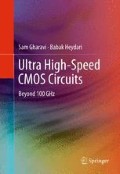Abstract
Circuit designers are mostly used to assume device models as given, instantiate their desired devices in their schematic windows, set up the simulation and run! They might perform their simulations in a number of different process corners and this is as much as they should worry about the whole notion of device modeling. mm-wave circuit design, at least for now, is an exception and both active and passive devices need extensive modeling. In this section, first reasons for this importance are discussed, then the device modeling procedure up to 100 GHz is presented and modeling results for single-transistor devices are shown. This follows by a discussion about measurement and de-embedding at these frequencies. Finally modeling of cascode devices are is included as an example of a multi-transistor structure.
Access this chapter
Tax calculation will be finalised at checkout
Purchases are for personal use only
Notes
- 1.
This is more explained in Chap. 5.
References
The BSIM 3v3 and 4.4.0 Website, http://www-device.eecs.berkeley.edu/bsim3BSIM Website
Cheng Y, Hu C (1999) MOSFET Modeling and BSIM3 User’s Guide. Springer, New York
Choong CY et al (2003) Small-signal substrate resistance effect in RF CMOS cascode amplifier. IEEE Microwave and Wireless Components Letters, vol 13, pp 253–255
Dambrine G et al (1988) A new method for determining the FET small-signal equivalentcircuit. IEEE Transaction on Microwave Theory and Techniques, vol 36, pp 1151–1159
Doan CH, Emami S, Niknejad AA, Brodersen RW (2005) Millimeter-Wave CMOS Design. IEEE Journal of Solid-State Circuits, vol 40, pp 144–155
EKV model website, http://legwww.epfl.ch/ekv/EKV Website
Emami S, Doan CH, Niknejad AM, Brodersen RW (2004) Large-signal millimeter-wave CMOS modeling with BSIM3. IEEE RFIC Symp Dig, pp 163–166
Enz C (2000) MOS transistor modeling for RF design. IEEE J of Solid-State Circuits, vol 35, pp 186–201
Gonzalez G (1996) Microwave Transistor Amplifiers. 2nd edn. Prentice-Hall Inc
Heydari B, Adabi E, Bohsali M, Afshar B, Arbabian MA, Niknejad AM (2007) Internal unilateralization technique for CMOS mm-wave amplifiers. RFIC Digest of Papers, pp 463–466
Heydari B, Bohsali M, Adabi E, Niknejad AM, mm-Wave Devices and Circuit blocks up to 104GHz in 90nm CMOS. IEEE J of Solid State Circuits, vol 42 pp 2893–2903
ICCAP website, http://eesof.tm.agilent.com/products/iccap_main.htmlICCAP website
Jia OJ et al (1998) CMOS RF modeling for GHz communication IC’s. Digest of Technical papers, VLSI symposium, pp 94–95
Kolding TE (2000) A four-step method for de-embedding gigahertz on-wafer CMOS measurements. IEEE Trans Electron Devices, vol 47, pp 734–740
Koolen MCAM et al (1991) An improved de-embedding Technique For on-wafer High-Frequency Characterization, IEEE Bipolar Circuits and Technology Meeting, pp 191–194
Lee TH (2003) The design of CMOS radio-frequency integrated circuits, 2nd edn. Cambridge University Press, Cambridge
Lovelace D et al (1994) Extracting small-signal model parameters of silicon MOSFETtransistors. Microwave Symposium Digest, vol 2, pp 865–868
MOS11 website, http://www.semiconductors.philips.com/Philips_Models/mos_models/model11/ MOS11 Website
Pozar DM (2004) Microwave Engineering. 3rd edn. Wiley
PSP model website, http://www.nxp.com/Philips_Models/mos_models/psp/PSP Website
Tsividis Y (2003) Operation and modeling of the MOS transistor, 2nd edn. Oxford University Press, Oxford
Wei X et al (2007) An improved on-chip 4-port parasitics de-embedding method with application to RF CMOS. 2007 Topical Meeting on Silicon Monolithic Integrated Circuits in RF Systems, pp 24–27
Ytterdal T, Cheng Y, Fjeldly TA (2003) Device modeling for analog and RF CMOS circuit design, 1st edn. Wiley, New York
Author information
Authors and Affiliations
Corresponding author
Rights and permissions
Copyright information
© 2011 Springer Science+Business Media, LLC
About this chapter
Cite this chapter
Gharavi, S., Heydari, B. (2011). mm-Wave Device Modeling. In: Ultra High-Speed CMOS Circuits. Springer, New York, NY. https://doi.org/10.1007/978-1-4614-0305-0_2
Download citation
DOI: https://doi.org/10.1007/978-1-4614-0305-0_2
Published:
Publisher Name: Springer, New York, NY
Print ISBN: 978-1-4614-0304-3
Online ISBN: 978-1-4614-0305-0
eBook Packages: EngineeringEngineering (R0)

